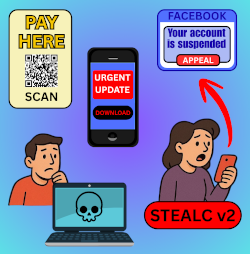
It began with seemingly innocuous messages. Users across the world received alerts on Facebook Messenger claiming to originate from official Facebook support. The messages warned that accounts were at risk of suspension due to suspicious activity and urged users to click a link to “appeal” or “fix” their accounts immediately. Many complied, unknowingly installing a sophisticated piece of malware called StealC v2.
Although Facebook is the most visible target, cybersecurity experts emphasize that StealC v2 is platform-agnostic. It can be delivered wherever users can be tricked into clicking a link or downloading a file. The malware has been observed using multiple channels, exploiting both technical vulnerabilities and human psychology to reach its victims.
Fake Facebook Account Suspension Alerts
One of the most effective tactics involves fake account suspension alerts. Victims receive messages that appear to come from official Facebook sources, warning them that their account has been compromised or will be suspended. The urgent tone provokes panic, prompting users to click a link to “secure” their account. Once clicked, StealC v2 may:
🛡️ Harvest login credentials and stored passwords
📸 Capture personal messages, photos, and other private data
🔗 Gain access to linked accounts such as email or other social media platforms
Even users familiar with online scams may be caught off guard because the alert appears legitimate.
Fake Software Updates on Mobile Devices
Another increasingly popular vector is fake system or app updates on smartphones and tablets. These prompts may appear as pop-ups while browsing websites, messages in third-party apps, or alerts disguised as updates for popular apps. Once the victim installs the “update,” StealC v2 or other malware can:
📱 Monitor keystrokes and messages
💳 Steal authentication codes and stored passwords
📂 Access photos, contacts, and sensitive app data
The malware may gain persistence on the device, making removal difficult without specialized tools.
QR Codes: Malicious Overlays on Legitimate Materials
Cybercriminals have started exploiting QR codes in the real world by placing them on top of legitimate posters, advertisements, flyers, or receipts. Unsuspecting users often scan them without questioning their origin, and these QR codes can:
📲 Redirect to malicious websites that deliver malware
🔑 Trigger downloads of StealC v2 or other infostealers
💻 Harvest sensitive information without requiring manual input
Because they are physically placed over authentic materials or reprinted in trusted contexts, these QR codes are much harder to identify as malicious, increasing the likelihood of victim interaction.
Crime-Video and Public Page Scams
Scammers also exploit curiosity and fear on public pages. Comments on police, neighborhood, or crime-watch pages often claim to contain video evidence of a crime. Examples include:
“CCTV caught your stolen car! Click here to watch.”
“We have footage of your incident. View it now!”
Clicking these links may:
🎥 Deliver StealC v2 or other malware, including remote access trojans (RATs) and spyware
💻 Lead to phishing pages requesting personal information or payments
🔍 Harvest sensitive data without installing any malware
While some of these scams deliver StealC v2, others may use different malware or rely purely on phishing tactics. The primary tool is social engineering—exploiting fear, curiosity, and urgency to prompt clicks.
Other Delivery Methods
StealC v2 is highly versatile and can also be delivered via:
📧 Email phishing campaigns mimicking banks, online services, or software companies
🌐 Compromised websites that trigger drive-by downloads
💬 Messaging apps such as WhatsApp or Telegram, where links are disguised as urgent messages
📲 SMS phishing (smishing) that mimics banks, package delivery services, or telecom providers
This adaptability makes almost anyone online a potential target.
How StealC v2 Operates
Once installed, StealC v2 is an infostealer, designed to quietly collect extensive data and transmit it to a remote control panel. It can:
🔑 Record passwords and browser cookies for social media, email, and banking sites
💰 Access cryptocurrency wallets and financial accounts
📷 Capture screenshots of sensitive activity
💬 Log chat histories and private messages
🛠️ Install additional tools to maintain persistence and control
The combination of technical sophistication and psychological manipulation is what makes StealC v2 exceptionally dangerous. Urgent alerts, fake updates, QR codes, and sensational posts exploit instinctive reactions to fear and curiosity.
Malware-as-a-Service: Low Skill, Global Reach
StealC v2 is available as Malware-as-a-Service (MaaS) on dark web marketplaces. Even individuals with minimal technical skill can deploy it globally. MaaS models enable attackers to:
🌍 Launch highly targeted campaigns across multiple platforms
⚙️ Automate infection and data harvesting
📊 Coordinate attacks efficiently, maximizing reach and impact
This model turns fear and curiosity into a highly profitable enterprise for cybercriminals.
Protecting Yourself and Your Community
Vigilance and skepticism are the best defenses. To stay safe:
🚫 Do not click unexpected links in messages, emails, comments, or pop-ups
🔍 Verify sources by accessing official websites directly
🔑 Never share passwords, two-factor codes, or financial information via messages
💻 Keep devices updated and install reputable security software
⏱️ Pause before reacting attackers rely on urgent, fear-inducing messages
⚠️ Report suspicious comments or posts to platform moderators
👥 Educate friends and family about QR codes, sensational content, and fake updates
StealC v2 and related scams are a stark reminder that modern cybercrime relies as much on psychology as technology. From fake Facebook alerts to QR codes, fake software updates, and crime-video page scams, attackers exploit human instinct, curiosity, and trust. Awareness, caution, and verification are the best defenses. In the digital age, even a single click can compromise your online life.
“StealC v2 does not just steal data. It exploits trust and instinct. Your only defense is awareness.”
- Log in to post comments
